Family Name: Ericaceae Jussieu
Synonym(s): Andromedaceae DC. ex Schnizl.; Arbutaceae Bromhead; Arctostaphylaceae J. Agardh; Azaleaceae Vest; Diplarchaceae Klotzsch; Empetraceae Hooker & Lindl., nom. cons.; Epacridaceae R. Br., nom. cons.; Hypopityaceae Klotzsch; Kalmiaceae Durande, nom. inval.; Ledaceae J. F. Gmel.; Menziesiaceae Klotzsch; Monotropaceae Nutt., nom. cons.; Prionotaceae Hutch.; Pyrolaceae Lindl., nom. cons.; Rhododendraceae Juss.; Rhodoraceae Vent.; Siphonandraceae Klotzsch, nom. inval.; Stypheliaceae Horan.; Vacciniaceae DC. ex Perleb, nom. cons.
Common Name(s): heath family
*Number of genera/species: 124/4,250
List of genera records in GRIN-Global
Fruit usually a loculicidalloculicidal:
type of capsular dehiscence, opening longitudinally through the locules (compare septicidal)
 or septicidal capsule or a berryberry:
or septicidal capsule or a berryberry:
an indehiscent, fleshy fruit with one or a few to many seeds. The flesh may be homogenous throughout. Or, if the outer part is hard, firm, or leathery, referred to as an hesperidium. Septa are present in some, and the seeds may be arillate or with a fleshy testa. with or without a persistent central column, rarely a drupedrupe:
with or without a persistent central column, rarely a drupedrupe:
(indehiscent drupe) a fleshy, indehiscent fruit with one more hard pits enclosing seeds, derived from single, superior, simple or compound ovary; (dehiscent drupe) a fruit with a dry or fibrous to fleshy or leathery outer husk that early to tardily breaks apart (or opens), exposing one or more nutlike pits enclosing the seeds , 1–25 mm, globoseglobose:
, 1–25 mm, globoseglobose:
3D shape—more or less spherical to angledangular:
to angledangular:
2D shape—having sides that meet at acute or obtuse angles
, tereteterete:
approximately circular in cross section; width and thickness approximately equal
 in transection, sometimes stylestyle:
in transection, sometimes stylestyle:
in a flower, the narrow and elongated part of the pistil between the stigma and the ovary; sometimes persisting in fruit and/or calyxcalyx:
and/or calyxcalyx:
the outer whorl of the perianth; all the sepals of a flower persistent, rarely with 5 broad wings (Agapetes spp.), with one to many seeds, sometimes enclosed by persistent calyxcalyx:
persistent, rarely with 5 broad wings (Agapetes spp.), with one to many seeds, sometimes enclosed by persistent calyxcalyx:
the outer whorl of the perianth; all the sepals of a flower , rarely calyxcalyx:
, rarely calyxcalyx:
the outer whorl of the perianth; all the sepals of a flower fleshy (Disterigma, Gaultheria). DrupesDrupe:
fleshy (Disterigma, Gaultheria). DrupesDrupe:
(indehiscent drupe) a fleshy, indehiscent fruit with one more hard pits enclosing seeds, derived from single, superior, simple or compound ovary; (dehiscent drupe) a fruit with a dry or fibrous to fleshy or leathery outer husk that early to tardily breaks apart (or opens), exposing one or more nutlike pits enclosing the seeds with 1–10 bonybony:
with 1–10 bonybony:
very hard and rather brittle, like bone
and smooth pyrenespyrene:
the hard inner portion of a drupe, consisting of a bony endocarp and an enclosed seed
, splitting or not at maturity. Pericarppericarp:
fruit wall or fruit coat
gray, black, purple, green, blue, brown, yellow, orange, red, or white, dulldull:
reflecting only a low proportion of incident light, with no apparent sheen , shinyshiny:
, shinyshiny:
uniformly reflecting a high proportion of incident light at all angles , or glaucous, dry, woodywoody:
, or glaucous, dry, woodywoody:
texture—consisting mainly of indurate lignified tissues, characteristic of or resembling wood
, fleshy, pulpy, or succulentsucculent:
texture—herbaceous and juicy, often thickened
, glabrousglabrous:
without hairs
or pubescentpubescent:
surface relief—bearing hairs
, smooth or granulargranular:
surface relief—having a grainy surface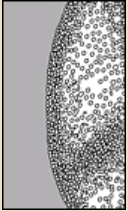 , groovedgrooved:
, groovedgrooved:
surface relief—linear depressions that may be single or form a series of grooves over the surface , ribbedribbed:
, ribbedribbed:
surface relief—wide, prominent, linear ridges that are generally rounded and longitudinally situated on the surface , ridgedridged:
, ridgedridged:
surface relief—raised, thick ridges, sharp edged or rounded, usually in a series that may cover the entire surface papillatepapillate:
papillatepapillate:
surface relief—bearing minute, distinct, broad-based projections, tapering to a rounded apex , reticulatereticulate:
, reticulatereticulate:
surface relief—netted, raised walls or concave grooves forming a net-like surface pattern with flat, concave, or convex interspaces , wartywarty:
, wartywarty:
surface relief—distinct, rounded projections that are large relative to the fruit size; tuberculate, verrucose , or scalyscaly:
, or scalyscaly:
surface relief—covered with small, thin, fine scales or flakes that may be removable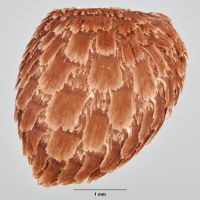 . CapsulesCapsule:
. CapsulesCapsule:
a dry, dehiscent fruit derived from a compound ovary often with small winged or tailed seeds.
often with small winged or tailed seeds.
Seeds ellipsoidellipsoid:
3D shape—elliptic
to angularangular:
2D shape—having sides that meet at acute or obtuse angles
, often D-shapedD-shaped:
2D shape—has one straight margin and one curved margin, resembling the shape of the letter D
, compressedcompressed:
flattened; in grasses, used to denote compression (not necessarily flattened) either laterally or dorsiventrally
or triangulartriangular:
2D shape—three relatively straight sides with distinct corners; more angular than teardrop-shaped in transection, 0.2–4 (rarely 10) mm. Often winged at both ends or wing encompassing seed or tailed at one or both ends. ElaiosomesElaiosome:
in transection, 0.2–4 (rarely 10) mm. Often winged at both ends or wing encompassing seed or tailed at one or both ends. ElaiosomesElaiosome:
a lipid and protein-rich fleshy structure attached to some seeds and fruits, it attracts ants which then disperse the disseminule (e.g., caruncle in the Euphorbiaceae, the aril (outgrowth of the funiculus) in the Fabaceae)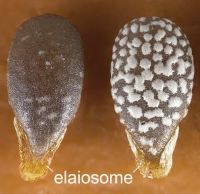 sometimes present (Erica spp.). Seed coat brown, orange, or white, rarely transparent (Erica spp.), dulldull:
sometimes present (Erica spp.). Seed coat brown, orange, or white, rarely transparent (Erica spp.), dulldull:
reflecting only a low proportion of incident light, with no apparent sheen or shinyshiny:
or shinyshiny:
uniformly reflecting a high proportion of incident light at all angles , thin (capsulescapsule:
, thin (capsulescapsule:
a dry, dehiscent fruit derived from a compound ovary ) or thick (berriesberry:
) or thick (berriesberry:
an indehiscent, fleshy fruit with one or a few to many seeds. The flesh may be homogenous throughout. Or, if the outer part is hard, firm, or leathery, referred to as an hesperidium. Septa are present in some, and the seeds may be arillate or with a fleshy testa. ), membranousmembranous:
), membranousmembranous:
texture—extremely thin, pliable, and fairly tough
, sometimes bonybony:
very hard and rather brittle, like bone
, hard, reticulatereticulate:
surface relief—netted, raised walls or concave grooves forming a net-like surface pattern with flat, concave, or convex interspaces , pittedpitted:
, pittedpitted:
surface relief—surface with small depressions in which the areas between the hollows do not take on the appearance of a true reticular net , striatestriate:
, striatestriate:
surface relief—having fine, parallel lines, grooves or ridges , longitudinally ribbedribbed:
, longitudinally ribbedribbed:
surface relief—wide, prominent, linear ridges that are generally rounded and longitudinally situated on the surface , sometimes mucilaginousmucilaginous:
, sometimes mucilaginousmucilaginous:
resembling mucilage; moist and sticky
. Hila punctate.
Embryo well-developed, partially filling seed cavity, sometimes rudimentaryrudimentary:
(of embryo) embryo is small and fills less than a quarter of the seed and can be variable in shapes, such as linear, spatulate, or oval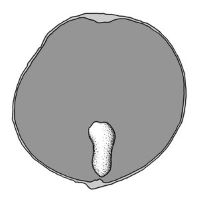 and minute, white, sometimes green, usually axileaxile:
and minute, white, sometimes green, usually axileaxile:
on or of the axis
and centric, sometimes basalbasal:
at or pertaining to the point of attachment; (of embryo) embryo occupies one end of the seed
, linearlinear:
(shape) long, narrow, and uniform in width; (of embryo) embryo is straight and much longer than wide , fusiformfusiform:
, fusiformfusiform:
spindle-shaped; broadest at the middle and tapering at both ends , or foliatefoliate:
, or foliatefoliate:
appearing leaf-like
, straight or curvedcurved:
(of embryo) linear embryo is curved into an arch or horseshoe with the ends far apart .
.
Endosperm usually copious, fleshy.
| Fruit | |
| Type | capsulecapsule: a dry, dehiscent fruit derived from a compound ovary  , berryberry: , berryberry:an indehiscent, fleshy fruit with one or a few to many seeds. The flesh may be homogenous throughout. Or, if the outer part is hard, firm, or leathery, referred to as an hesperidium. Septa are present in some, and the seeds may be arillate or with a fleshy testa.  , rarely a drupedrupe: , rarely a drupedrupe:(indehiscent drupe) a fleshy, indehiscent fruit with one more hard pits enclosing seeds, derived from single, superior, simple or compound ovary; (dehiscent drupe) a fruit with a dry or fibrous to fleshy or leathery outer husk that early to tardily breaks apart (or opens), exposing one or more nutlike pits enclosing the seeds  |
| Size range | 1–25 mm long |
| Shape(s) | globoseglobose: 3D shape—more or less spherical  , hemisphericalhemispherical: , hemisphericalhemispherical:2D shape—shaped like half a sphere , ellipsoidalellipsoid: 3D shape—elliptic , cylindricalcylindrical: 3D shape—a cylinder, with parallel sides and a circular cross-section; tubular or rod-shaped ,pear-shaped, ovoidovoid: 3D shape—ovate  , obovoidobovoid: , obovoidobovoid:3D shape—obovate , oblongoblong: 2D shape—much longer than broad with nearly parallel sides, corners are rounded  , angledangular: , angledangular:2D shape—having sides that meet at acute or obtuse angles |
| Texture | dry, woodywoody: texture—consisting mainly of indurate lignified tissues, characteristic of or resembling wood , fleshy, pulpy, succulentsucculent: texture—herbaceous and juicy, often thickened |
| Surface relief | smooth, granulargranular: surface relief—having a grainy surface  , groovedgrooved: , groovedgrooved:surface relief—linear depressions that may be single or form a series of grooves over the surface  , ribbedribbed: , ribbedribbed:surface relief—wide, prominent, linear ridges that are generally rounded and longitudinally situated on the surface  , ridgedridged: , ridgedridged:surface relief—raised, thick ridges, sharp edged or rounded, usually in a series that may cover the entire surface  papillatepapillate: papillatepapillate:surface relief—bearing minute, distinct, broad-based projections, tapering to a rounded apex  , reticulatereticulate: , reticulatereticulate:surface relief—netted, raised walls or concave grooves forming a net-like surface pattern with flat, concave, or convex interspaces  , wartywarty: , wartywarty:surface relief—distinct, rounded projections that are large relative to the fruit size; tuberculate, verrucose  , scalyscaly: , scalyscaly:surface relief—covered with small, thin, fine scales or flakes that may be removable  |
| Color(s) | gray, black, purple, green, blue, brown, yellow, orange, red, white |
| Unique features | CapsulesCapsule: a dry, dehiscent fruit derived from a compound ovary  or berriesberry: or berriesberry:an indehiscent, fleshy fruit with one or a few to many seeds. The flesh may be homogenous throughout. Or, if the outer part is hard, firm, or leathery, referred to as an hesperidium. Septa are present in some, and the seeds may be arillate or with a fleshy testa.  with minute to small seeds, often winged or tailed. with minute to small seeds, often winged or tailed. |
| Seed | |
| Size range | usually 0.2–4 mm long |
| Shape(s) | ellipsoidellipsoid: 3D shape—elliptic , fusiformfusiform: spindle-shaped; broadest at the middle and tapering at both ends  , conicalconical: , conicalconical:3D shape—cone-shaped, with the point of attachment at the broad end 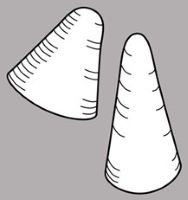 , ovoidovoid: , ovoidovoid:3D shape—ovate  , pear-shaped, oblongoblong: , pear-shaped, oblongoblong:2D shape—much longer than broad with nearly parallel sides, corners are rounded  , D-shapedD-shaped: , D-shapedD-shaped:2D shape—has one straight margin and one curved margin, resembling the shape of the letter D , wedge-shapedwedge-shaped: 2D shape—triangular and tapering to a point at the base 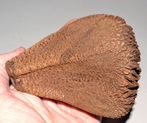 , cuneiformcuneiform: , cuneiformcuneiform:wedge-shaped , angularangular: 2D shape—having sides that meet at acute or obtuse angles |
| Surface relief | hard, reticulatereticulate: surface relief—netted, raised walls or concave grooves forming a net-like surface pattern with flat, concave, or convex interspaces  , pittedpitted: , pittedpitted:surface relief—surface with small depressions in which the areas between the hollows do not take on the appearance of a true reticular net  , striatestriate: , striatestriate:surface relief—having fine, parallel lines, grooves or ridges  , longitudinally ribbed , longitudinally ribbed |
| Color(s) | brown, orange, white |
| Unique features | Minute to small seeds often winged or tailed. |
| Other | |
| Embryo | well-developed, partially filling seed cavity, sometimes rudimentaryrudimentary: (of embryo) embryo is small and fills less than a quarter of the seed and can be variable in shapes, such as linear, spatulate, or oval  and minute, white, sometimes green, usually axileaxile: and minute, white, sometimes green, usually axileaxile:on or of the axis and centric, sometimes basalbasal: at or pertaining to the point of attachment; (of embryo) embryo occupies one end of the seed , linearlinear: (shape) long, narrow, and uniform in width; (of embryo) embryo is straight and much longer than wide  , fusiformfusiform: , fusiformfusiform:spindle-shaped; broadest at the middle and tapering at both ends  , or foliatefoliate: , or foliatefoliate:appearing leaf-like , straight or curvedcurved: (of embryo) linear embryo is curved into an arch or horseshoe with the ends far apart  |
| Nutritive tissue | endosperm usually copious, fleshy |
Worldwide distribution
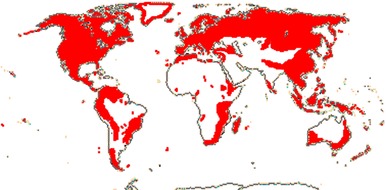
Distribution map courtesy of Angiosperm Phylogeny Website.
Crowden et al. 2023Crowden et al. 2023:
Crowden RK, Duretto MF, and de Salas MF. 2023. Ericaceae. In: de Salas MF, ed. Flora of Tasmania Online. Tasmanian Herbarium, Tasmanian Museum and Art Gallery, Hobart. 83 pp. Accessed December 2023. URL: https://flora.tmag.tas.gov.au/vascular-families/ericaceae/; Flora of North America Editorial Committee 1993+Flora of North America Editorial Committee 1993+:
Flora of North America Editorial Committee, eds. 1993+. Flora of North America North of Mexico [Online]. 22+ vols. Flora of North America Association, New York and Oxford. Accessed January-March 2024. URL: http://beta.floranorthamerica.org.; Judd 1981Judd 1981:
Judd WS. 1981. A monograph of Lyonia (Ericaceae). Journal of the Arnold Arboretum 62: 315–436; Luteyn 1976aLuteyn 1976a:
Luteyn JL. 1976a. Notes on Neotropical Vaccinieae (Ericaceae). I. Gonocalyx-A genus New to Central America. Brittonia 28: 37–41; Luteyn 1976bLuteyn 1976b:
Luteyn JL. 1976b. Notes on Neotropical Vaccinieae (Ericaceae). III. New and noteworthy species from Mexico and Central America. Brittonia 28: 400–406; Luteyn 1977Luteyn 1977:
Luteyn JL. 1977. Notes on Neotropical Vaccinieae (Ericaceae). IV. A review of the genus Oreanthes. Brittonia 29: 173–176; Luteyn 1983Luteyn 1983:
Luteyn JL. 1983. Ericaceae: Part I. Cavendishia. Flora Neotropica 35: 1–289.; Luteyn 1984Luteyn 1984:
Luteyn JL. 1984. Revision of Semiramisia (Ericaceae: Vaccinieae). Systematic Botany 9: 359–367; Luteyn 1991Luteyn 1991:
Luteyn JL. 1991. A synopsis of the genus Didonica (Ericaceae: Vaccinieae) with two new species. Systematic Botany 16: 587–597; Luteyn 1992Luteyn 1992:
Luteyn JL. 1992. Plutarchia ecuadorensis (Ericaceae, Vaccinieae): A new species and a new generic record for Ecuador. Brittonia 44: 240–243; Luteyn 2019Luteyn 2019:
Luteyn JL. 2019. Typification in and contributions to a revision of Psammisia (Ericaceae: Vaccinieae). Journal of the Botanical Research Institute of Texas 13: 397–449; Luteyn and Ortiz 2008Luteyn and Ortiz 2008:
Luteyn JL and Ortiz EM. 2008. Revision of Siphonandra (Ericaceae: Vacinnieae), a genus endemic to Peru and Bolivia. Journal of the Botanical Research Institute of Texas 2: 249–261; Luteyn and Wilbur 1977Luteyn and Wilbur 1977:
Luteyn JL and Wilbur RL. 1977. New genera and species of Ericaceae (Vaccinieae) from Costa Rica and Panama. Brittonia 29: 255–276; Luteyn et al. 1995Luteyn et al. 1995:
Luteyn JL, Clemants SE, Diggs GM, Dorr LJ, Judd WS, Sørensen PD, Stevens PF, and Wallace GD. 1995. Ericaceae: Part II. The superior-ovaried genera (Monotropoideae, Pyroloideae, Rhododendroideae, and Vaccinioideae P.P.). Flora Neotropica 66: 1–560.; Kirkbride et al. 2006Kirkbride et al. 2006:
Kirkbride JH, Jr, Gunn CR, and Dallwitz MJ. 2006. Family guide for fruits and seeds, vers. 1.0. Accessed September 2020-January 2022. URL: https://nt.ars-grin.gov/seedsfruits/keys/frsdfam/index.cfm .; Kubitzki et al. 1990+Kubitzki et al. 1990+:
Kubitzki K et al., eds. 1990+. The families and genera of vascular plants. 7+ vols. Berlin etc.; Pedraza-Peñalosa 2010Pedraza-Peñalosa 2010:
Pedraza-Peñalosa P. 2010. Disterigma (Ericaceae: Vaccinieae). Flora Neotropica 108: 1–126; PlantNET 2021+PlantNET 2021+:
PlantNET (The NSW Plant Information Network System). 2021+. Royal Botanic Gardens and Domain Trust, Sydney. Accessed January 2021–March 2024. URL: https://plantnet.rbgsyd.nsw.gov.au;Takhtajan 2009Takhtajan 2009:
Takhtajan A. 2009. Flowering plants: Second edition. Springer Nature, Switzerland. 871 pp.; Tutin et al. 1964–1980Tutin et al. 1964–1980:
Tutin TG, Burges NA, Chater AO, Edmondson JR, Heywood VH, Moore DM, Valentine DH, Walters SM, and Webb DA (eds.) 1964–1980. Flora Europaea. 5 vols. Cambridge University Press, Cambridge UK. 2,524 pp.; Ulloa Ulloa and Jørgensen 2004 and onwardsUlloa Ulloa and Jørgensen 2004 and onwards:
Ulloa Ulloa C and Jørgensen PM. 2004 and onwards. Árboles y arbustos de los Andes del Ecuador. URL: http://www.efloras.org/flora_page.aspx?flora_id=201; Wilbur and Luteyn 1978Wilbur and Luteyn 1978:
Wilbur RL and Luteyn JL. 1978. Family 149. Ericaceae. Flora of Panama 65: 27–143; Wilbur and Luteyn 2008Wilbur and Luteyn 2008:
Wilbur RL and Luteyn JL. 2008. A synopsis of the Mexican and Central America species of Vaccinium (Ericaceae). Journal of the Botanical Research Institute of Texas 2: 207–241; Zhengyi et al. 2004+Zhengyi et al. 2004+:
Zhengyi W, Raven PH, and Deyuan H. 2004+. Flora of China [online]. 25 vols. Science Press, Beijing China & Missouri Botanical Garden, St. Louis USA. Accessed January–March 2024. http://flora.huh.harvard.edu/china/
*The number of genera and species is based on Christenhusz and Byng 2016Christenhusz and Byng 2016:
Christenhusz MJM and Byng JW. 2016. The number of known plant species in the world and its annual increase. Phytotaxa 261 (3): 201-217. https://doi.org/10.11646/phytotaxa.261.3.1, which may differ from the number of genera in GRIN-Global.